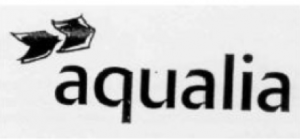Judgement of the General Court, 25 February 2016. Case: T-402/14 FCC Aqualia, S.A vs. OHIM.
Likelihood of confusion. Article 8(1)(b) and 5, of Regulation (EC) Nº 207/2009: “if because of its identity with or similarity to the earlier trade mark and the identity or similarity of the goods or services covered by the trade marks there exists a likelihood of confusion on the part of the public in the territory in which the earlier trade mark is protected; the likelihood of confusion includes the likelihood of association with the earlier trade mark”.
Sociedad General de Aguas de Barcelona, S.A. filed an application for registration of the following figurative mark as a Community trade mark:
The goods for which registration was sought, relevant to this Judgement, were for advertising, business management, construction services, repair, installation, transport, packing and storage of goods, treatment of materials, scientific and technological services, and research and design relating thereto, industrial analysis and research services, design and development of computer hardware and software (covered by Classes 35, 37, 39, 40 and 42 of the Nice Agreement).
FCC Aqualia, S.A. filed a notice of opposition against the registration of the requested mark, based on two earlier marks, the Community word mark AQUALIA and the following national figurative trade mark:

The Opposition Division rejected the opposition filed in its entirety, and FCC Aqualia, S.A. lodged an appeal with OHIM; the First Board of Appeal of OHIM dismissed the appeal and so this decision was appealed against before the General Court.
The Judgement of the General Court dismissed the appeal in its entirety, for the following reasons:

Regarding the relevant public, FCC Aqualia, S.A. maintains that the Board of Appeal erred in holding that the relevant public is only composed of institutional users with a very high level of attention. In their view, the relevant public also comprises an end consumer/user, which is deemed to be reasonably well informed and reasonably observant and circumspect.
The General Court concludes that, in the current case, the end consumer/user is not the person choosing the services in question and the corresponding brands, and this person is absent at the crucial moment in time that the choice is made by the institutional user, and thereby resolves that the end consumer/user cannot be included as relevant public for the purposes of the application of Article 8(1)(b) of Regulation Nº 207/2009.
Regarding the comparison of the signs, FCC Aqualia, S.A. contends that the degree of similarity between the signs in conflict is significantly higher than that noted by the Board of Appeal. In particular, it is claimed that conceptually, the two conflictive signs are neologisms, that both have the expression “aqua” in common.
The General Court dismisses these claims as, while it is true that the element “aqua” evokes the purpose of the services at issue, that these are related to water, such an assessment confers average distinctive character. Moreover, the mentioned element is neither dominant nor viewed more prominently than the suffixes of the signs at issue, and which in all the marks in question, makes up just one word. Furthermore, the suffixes “logy” and “lia” do not strengthen the conceptual reference to the idea of water, but, on the contrary, confer a different conceptual content to the signs in question. For these reasons, the claim regarding the semantic association, that the root “aqua” determines between both signs will always predominate above the possible difference that the suffice “logy” could establish between them, is dismissed.
Lastly, regarding the likelihood of confusion, FCC Aqualia, S.A. sustains that the Board of Appeal should have taken into account the highly distinctive character and the reputation of the earlier marks with respect to the assessment of the likelihood of confusion and to provide it with the corresponding value when assessing the factors determining the likelihood of confusion.
The General Court dismisses this plea as, regarding this current case, the similarity between the trade mark applied for and the earlier trade marks clearly goes no further than the descriptive element “aqua”.


 Español
Español Deutsch
Deutsch